FHS215: Analyzing Health Data Using Quantitative Methods
VerifiedAdded on 2023/06/14
|19
|3789
|394
Report
AI Summary
This report explores quantitative research methods in social science, analyzing a dataset of 10617 individuals to determine factors impacting health, particularly alcohol consumption. The study uses statistical methods like central tendency, cross-tabulation, and correlation to identify relationships between variables such as age, gender, income, and drinking habits. The findings indicate a higher prevalence of alcohol consumption among women and a correlation between income levels and alcohol intake. The report also compares these findings with secondary data, highlighting trends in alcohol-related deaths and consumption patterns in the UK. The analysis rejects the null hypothesis in most cases, suggesting a strong dependency between the independent variables examined, with the exception of total household income and sex. The report concludes with recommendations for addressing alcohol-related health issues based on the data analysis. Desklib provides access to similar reports and solved assignments for students.
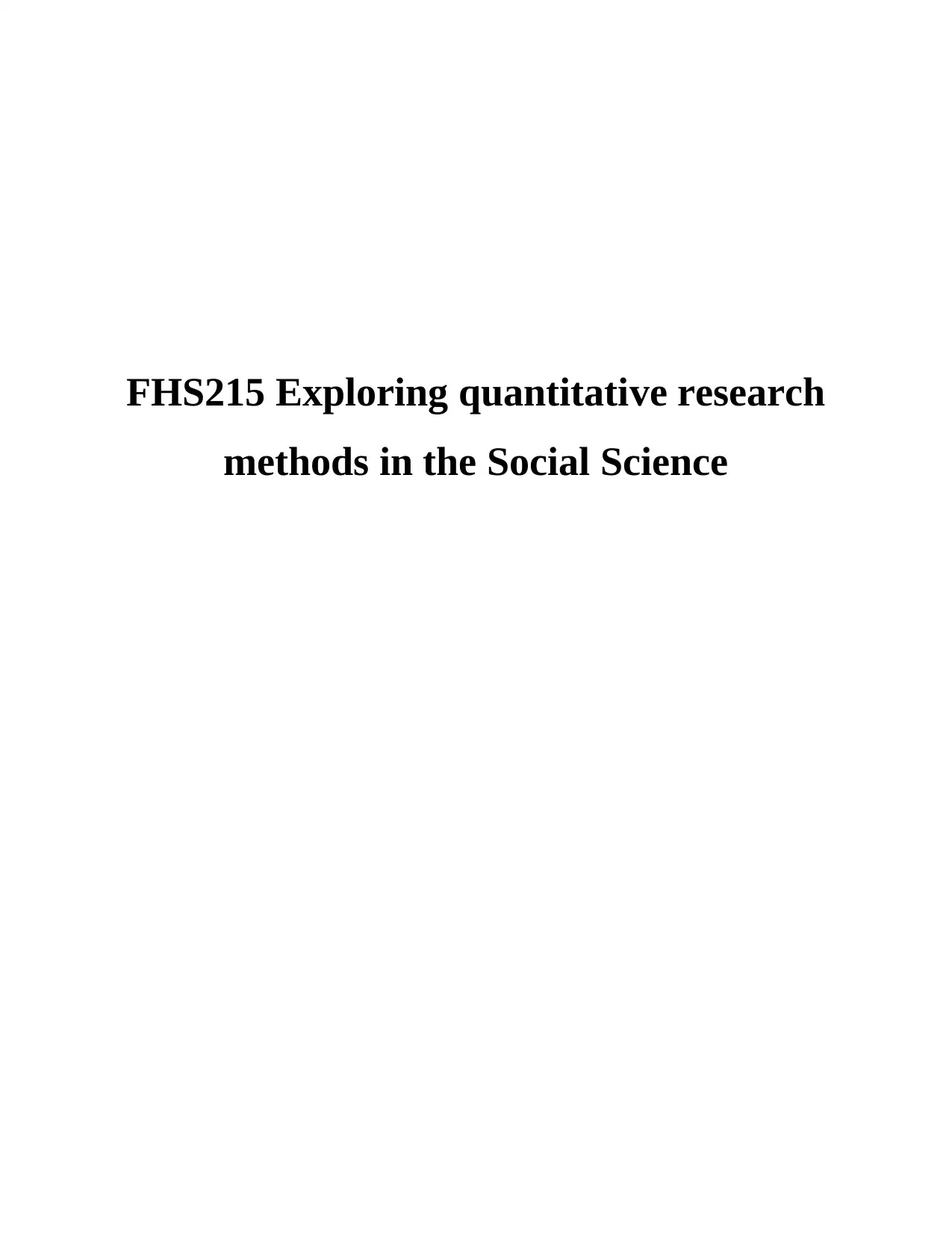
FHS215 Exploring quantitative research
methods in the Social Science
methods in the Social Science
Paraphrase This Document
Need a fresh take? Get an instant paraphrase of this document with our AI Paraphraser

Table of Contents
INTRODUCTION...........................................................................................................................3
Sample size..................................................................................................................................3
% of people drink alcohol............................................................................................................3
% of women in sample................................................................................................................4
Highest education level................................................................................................................5
% of separated or divorces people...............................................................................................7
% of white people........................................................................................................................7
Central tendency of household size.............................................................................................8
Central tendency of age at last birthday....................................................................................10
CROSS TABULATION................................................................................................................11
Which sex drinks alcohol more.................................................................................................11
Which region drinks alcohol most.............................................................................................12
CORRELATION...........................................................................................................................13
DISCUSSION................................................................................................................................15
Implication.................................................................................................................................16
CONCLUSION..............................................................................................................................17
Recommendations......................................................................................................................17
REFERENCES..............................................................................................................................19
INTRODUCTION...........................................................................................................................3
Sample size..................................................................................................................................3
% of people drink alcohol............................................................................................................3
% of women in sample................................................................................................................4
Highest education level................................................................................................................5
% of separated or divorces people...............................................................................................7
% of white people........................................................................................................................7
Central tendency of household size.............................................................................................8
Central tendency of age at last birthday....................................................................................10
CROSS TABULATION................................................................................................................11
Which sex drinks alcohol more.................................................................................................11
Which region drinks alcohol most.............................................................................................12
CORRELATION...........................................................................................................................13
DISCUSSION................................................................................................................................15
Implication.................................................................................................................................16
CONCLUSION..............................................................................................................................17
Recommendations......................................................................................................................17
REFERENCES..............................................................................................................................19
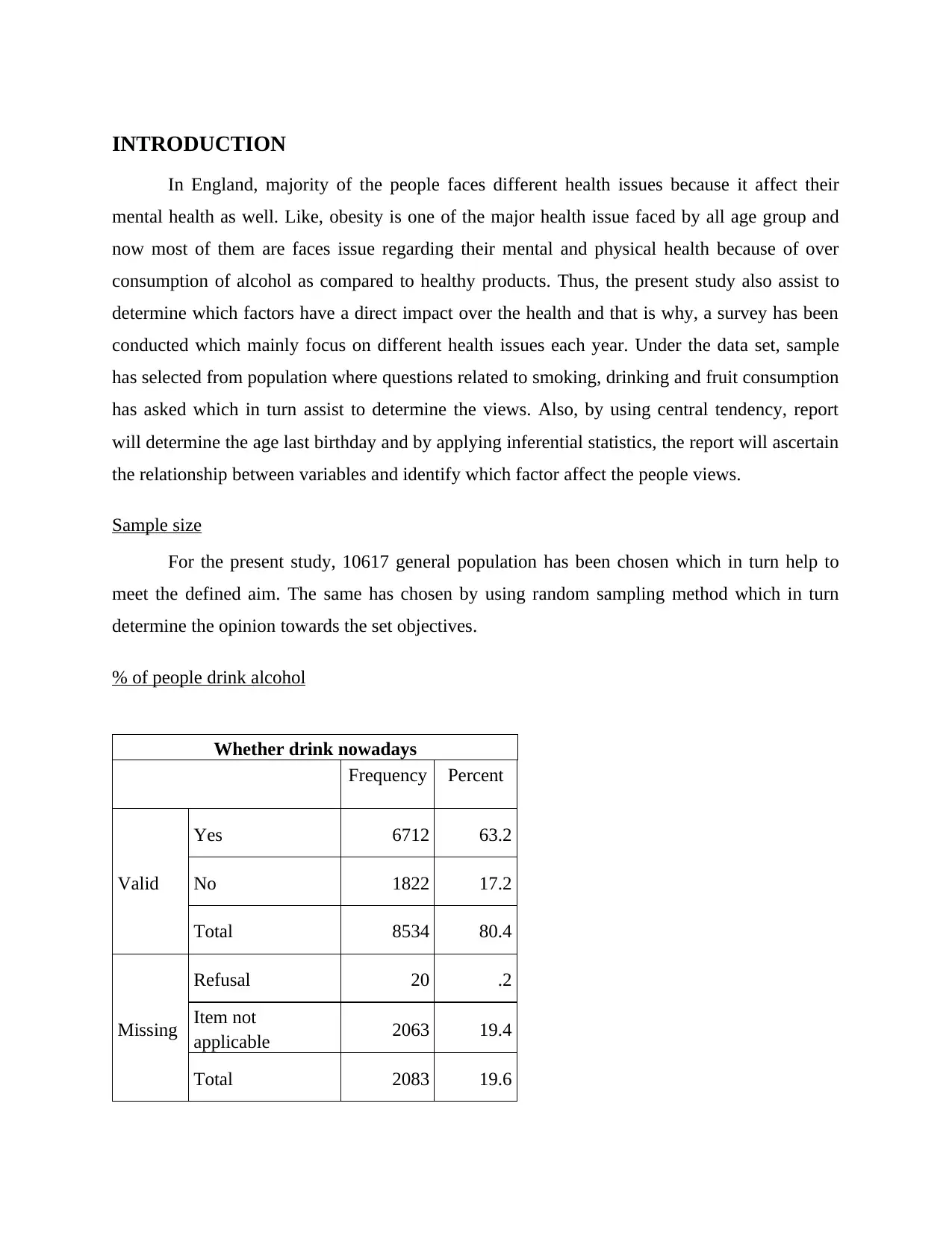
INTRODUCTION
In England, majority of the people faces different health issues because it affect their
mental health as well. Like, obesity is one of the major health issue faced by all age group and
now most of them are faces issue regarding their mental and physical health because of over
consumption of alcohol as compared to healthy products. Thus, the present study also assist to
determine which factors have a direct impact over the health and that is why, a survey has been
conducted which mainly focus on different health issues each year. Under the data set, sample
has selected from population where questions related to smoking, drinking and fruit consumption
has asked which in turn assist to determine the views. Also, by using central tendency, report
will determine the age last birthday and by applying inferential statistics, the report will ascertain
the relationship between variables and identify which factor affect the people views.
Sample size
For the present study, 10617 general population has been chosen which in turn help to
meet the defined aim. The same has chosen by using random sampling method which in turn
determine the opinion towards the set objectives.
% of people drink alcohol
Whether drink nowadays
Frequency Percent
Valid
Yes 6712 63.2
No 1822 17.2
Total 8534 80.4
Missing
Refusal 20 .2
Item not
applicable 2063 19.4
Total 2083 19.6
In England, majority of the people faces different health issues because it affect their
mental health as well. Like, obesity is one of the major health issue faced by all age group and
now most of them are faces issue regarding their mental and physical health because of over
consumption of alcohol as compared to healthy products. Thus, the present study also assist to
determine which factors have a direct impact over the health and that is why, a survey has been
conducted which mainly focus on different health issues each year. Under the data set, sample
has selected from population where questions related to smoking, drinking and fruit consumption
has asked which in turn assist to determine the views. Also, by using central tendency, report
will determine the age last birthday and by applying inferential statistics, the report will ascertain
the relationship between variables and identify which factor affect the people views.
Sample size
For the present study, 10617 general population has been chosen which in turn help to
meet the defined aim. The same has chosen by using random sampling method which in turn
determine the opinion towards the set objectives.
% of people drink alcohol
Whether drink nowadays
Frequency Percent
Valid
Yes 6712 63.2
No 1822 17.2
Total 8534 80.4
Missing
Refusal 20 .2
Item not
applicable 2063 19.4
Total 2083 19.6
⊘ This is a preview!⊘
Do you want full access?
Subscribe today to unlock all pages.

Trusted by 1+ million students worldwide
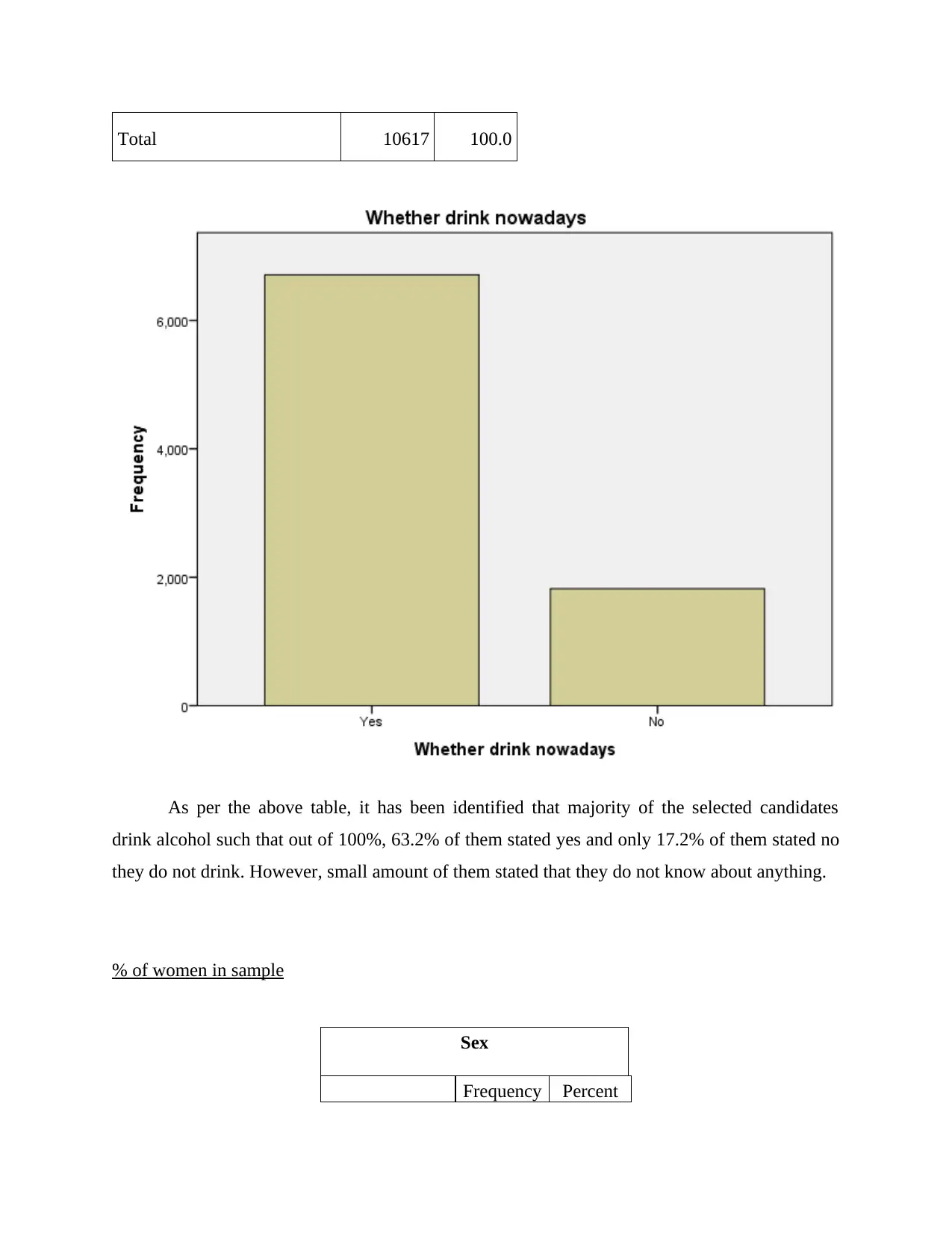
Total 10617 100.0
As per the above table, it has been identified that majority of the selected candidates
drink alcohol such that out of 100%, 63.2% of them stated yes and only 17.2% of them stated no
they do not drink. However, small amount of them stated that they do not know about anything.
% of women in sample
Sex
Frequency Percent
As per the above table, it has been identified that majority of the selected candidates
drink alcohol such that out of 100%, 63.2% of them stated yes and only 17.2% of them stated no
they do not drink. However, small amount of them stated that they do not know about anything.
% of women in sample
Sex
Frequency Percent
Paraphrase This Document
Need a fresh take? Get an instant paraphrase of this document with our AI Paraphraser
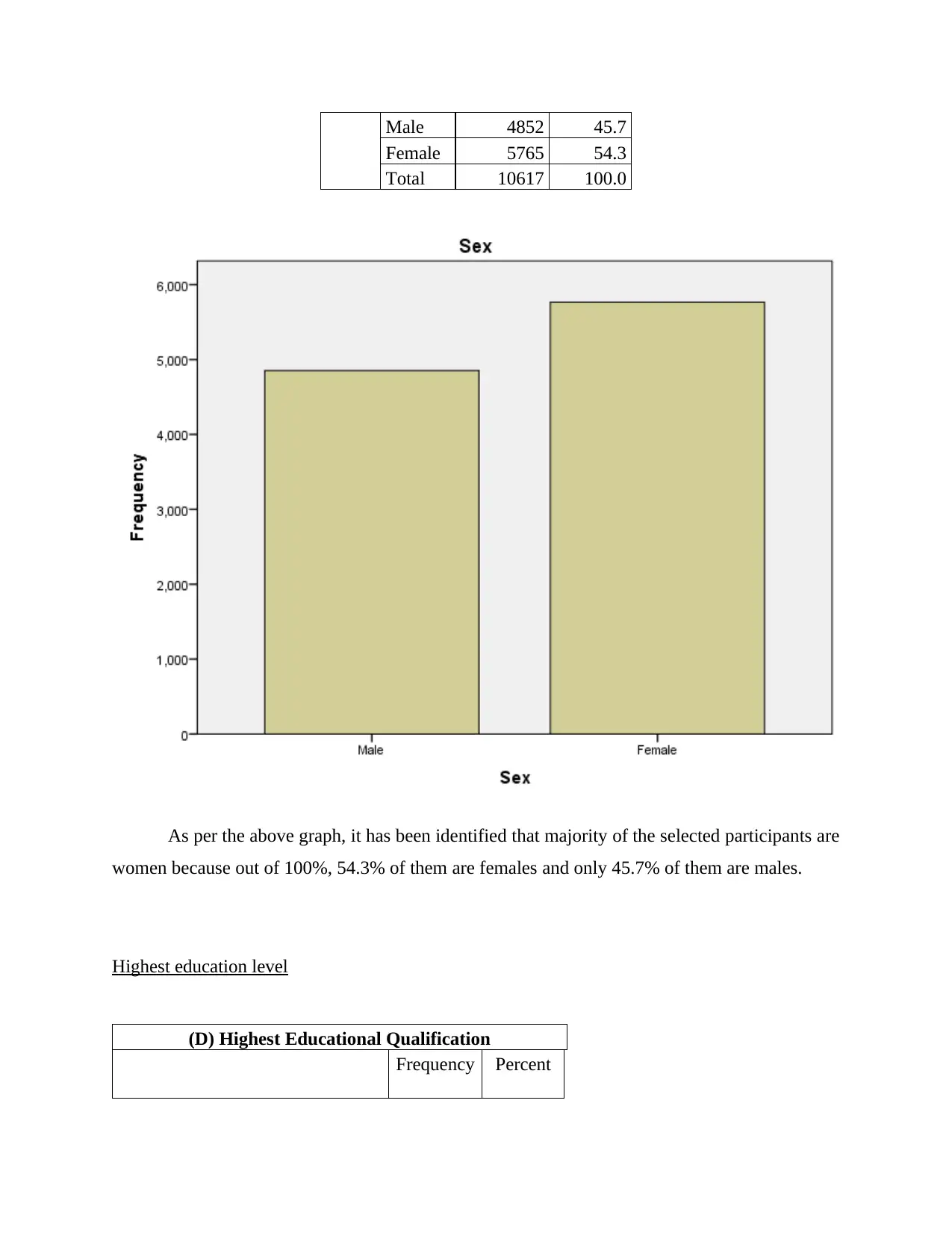
Male 4852 45.7
Female 5765 54.3
Total 10617 100.0
As per the above graph, it has been identified that majority of the selected participants are
women because out of 100%, 54.3% of them are females and only 45.7% of them are males.
Highest education level
(D) Highest Educational Qualification
Frequency Percent
Female 5765 54.3
Total 10617 100.0
As per the above graph, it has been identified that majority of the selected participants are
women because out of 100%, 54.3% of them are females and only 45.7% of them are males.
Highest education level
(D) Highest Educational Qualification
Frequency Percent

Valid
NVQ4/NVQ5/Degree or
equiv 2008 18.9
Higher ed below degree 948 8.9
NVQ3/GCE A Level
equiv 1248 11.8
NVQ2/GCE O Level
equiv 1803 17.0
NVQ1/CSE other grade
equiv 395 3.7
Foreign/other 127 1.2
No qualification 2037 19.2
Total 8566 80.7
Missing Not applicable 2051 19.3
Total 10617 100.0
NVQ4/NVQ5/Degree or
equiv 2008 18.9
Higher ed below degree 948 8.9
NVQ3/GCE A Level
equiv 1248 11.8
NVQ2/GCE O Level
equiv 1803 17.0
NVQ1/CSE other grade
equiv 395 3.7
Foreign/other 127 1.2
No qualification 2037 19.2
Total 8566 80.7
Missing Not applicable 2051 19.3
Total 10617 100.0
⊘ This is a preview!⊘
Do you want full access?
Subscribe today to unlock all pages.

Trusted by 1+ million students worldwide
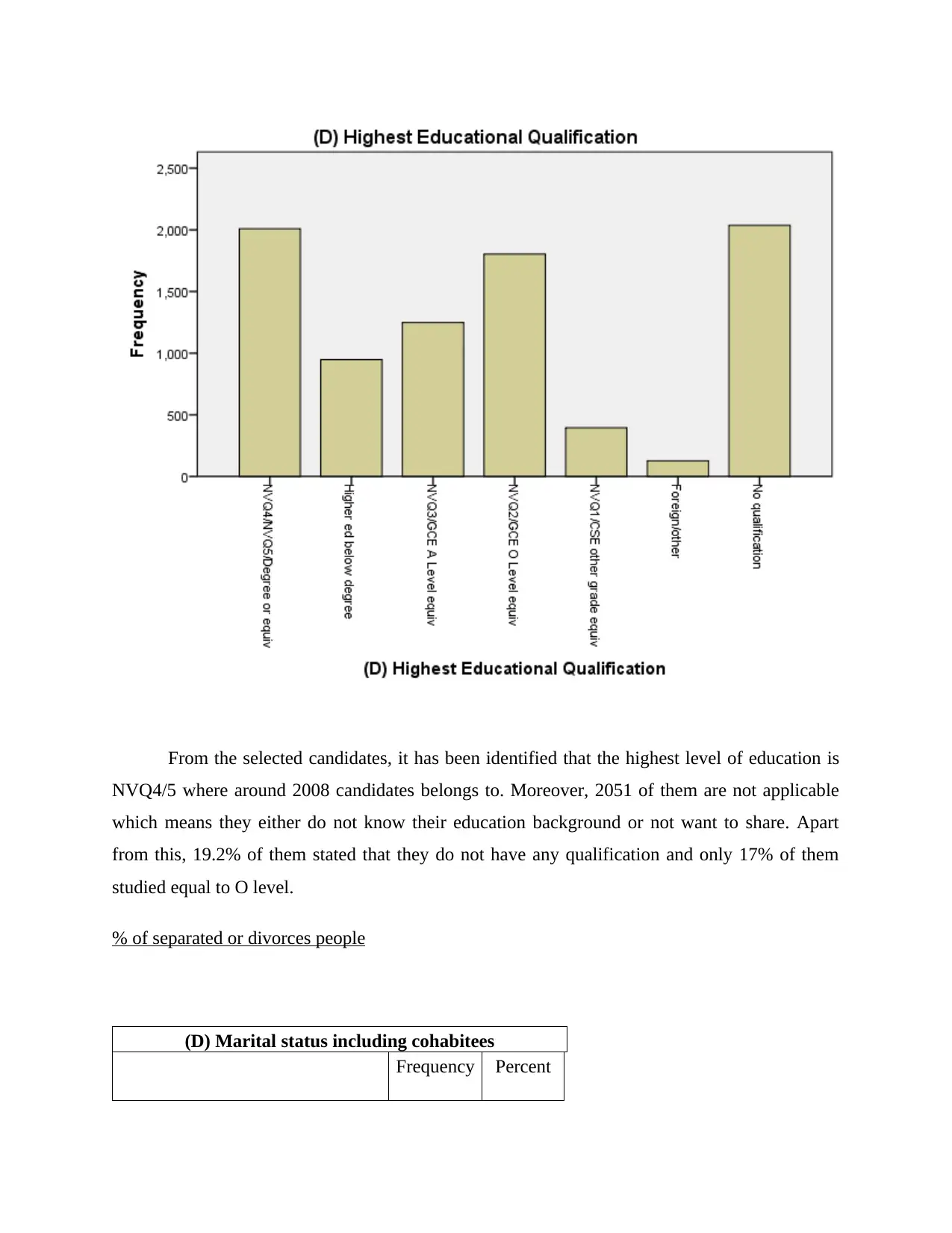
From the selected candidates, it has been identified that the highest level of education is
NVQ4/5 where around 2008 candidates belongs to. Moreover, 2051 of them are not applicable
which means they either do not know their education background or not want to share. Apart
from this, 19.2% of them stated that they do not have any qualification and only 17% of them
studied equal to O level.
% of separated or divorces people
(D) Marital status including cohabitees
Frequency Percent
NVQ4/5 where around 2008 candidates belongs to. Moreover, 2051 of them are not applicable
which means they either do not know their education background or not want to share. Apart
from this, 19.2% of them stated that they do not have any qualification and only 17% of them
studied equal to O level.
% of separated or divorces people
(D) Marital status including cohabitees
Frequency Percent
Paraphrase This Document
Need a fresh take? Get an instant paraphrase of this document with our AI Paraphraser

Separated 224 2.1
Divorced 594 5.6
Total 818
Separated Divorced
0
100
200
300
400
500
600
224
594
As per the above graph, it has been identified that 5.6% of the total selected sample size
are divorced and only 2.1% of them are separated.
% of white people
Ethnic origin of individual
Frequency Percent
White -
English/Welsh/Scottish/
Northern Irish/British
8671 81.7
White - Irish 84 .8
Divorced 594 5.6
Total 818
Separated Divorced
0
100
200
300
400
500
600
224
594
As per the above graph, it has been identified that 5.6% of the total selected sample size
are divorced and only 2.1% of them are separated.
% of white people
Ethnic origin of individual
Frequency Percent
White -
English/Welsh/Scottish/
Northern Irish/British
8671 81.7
White - Irish 84 .8
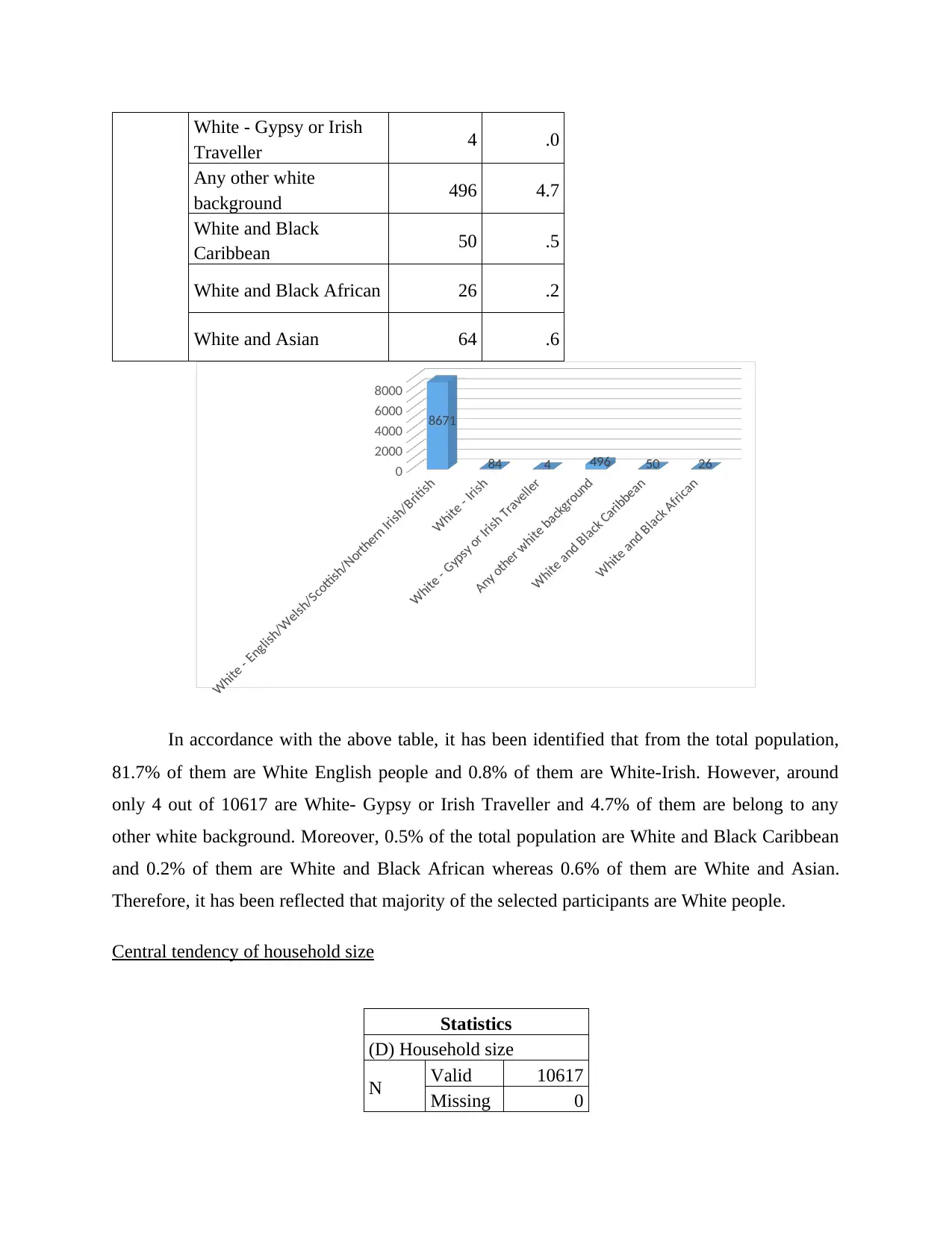
White - Gypsy or Irish
Traveller 4 .0
Any other white
background 496 4.7
White and Black
Caribbean 50 .5
White and Black African 26 .2
White and Asian 64 .6
0
2000
4000
6000
8000
8671
84 4 496 50 26
In accordance with the above table, it has been identified that from the total population,
81.7% of them are White English people and 0.8% of them are White-Irish. However, around
only 4 out of 10617 are White- Gypsy or Irish Traveller and 4.7% of them are belong to any
other white background. Moreover, 0.5% of the total population are White and Black Caribbean
and 0.2% of them are White and Black African whereas 0.6% of them are White and Asian.
Therefore, it has been reflected that majority of the selected participants are White people.
Central tendency of household size
Statistics
(D) Household size
N Valid 10617
Missing 0
Traveller 4 .0
Any other white
background 496 4.7
White and Black
Caribbean 50 .5
White and Black African 26 .2
White and Asian 64 .6
0
2000
4000
6000
8000
8671
84 4 496 50 26
In accordance with the above table, it has been identified that from the total population,
81.7% of them are White English people and 0.8% of them are White-Irish. However, around
only 4 out of 10617 are White- Gypsy or Irish Traveller and 4.7% of them are belong to any
other white background. Moreover, 0.5% of the total population are White and Black Caribbean
and 0.2% of them are White and Black African whereas 0.6% of them are White and Asian.
Therefore, it has been reflected that majority of the selected participants are White people.
Central tendency of household size
Statistics
(D) Household size
N Valid 10617
Missing 0
⊘ This is a preview!⊘
Do you want full access?
Subscribe today to unlock all pages.

Trusted by 1+ million students worldwide
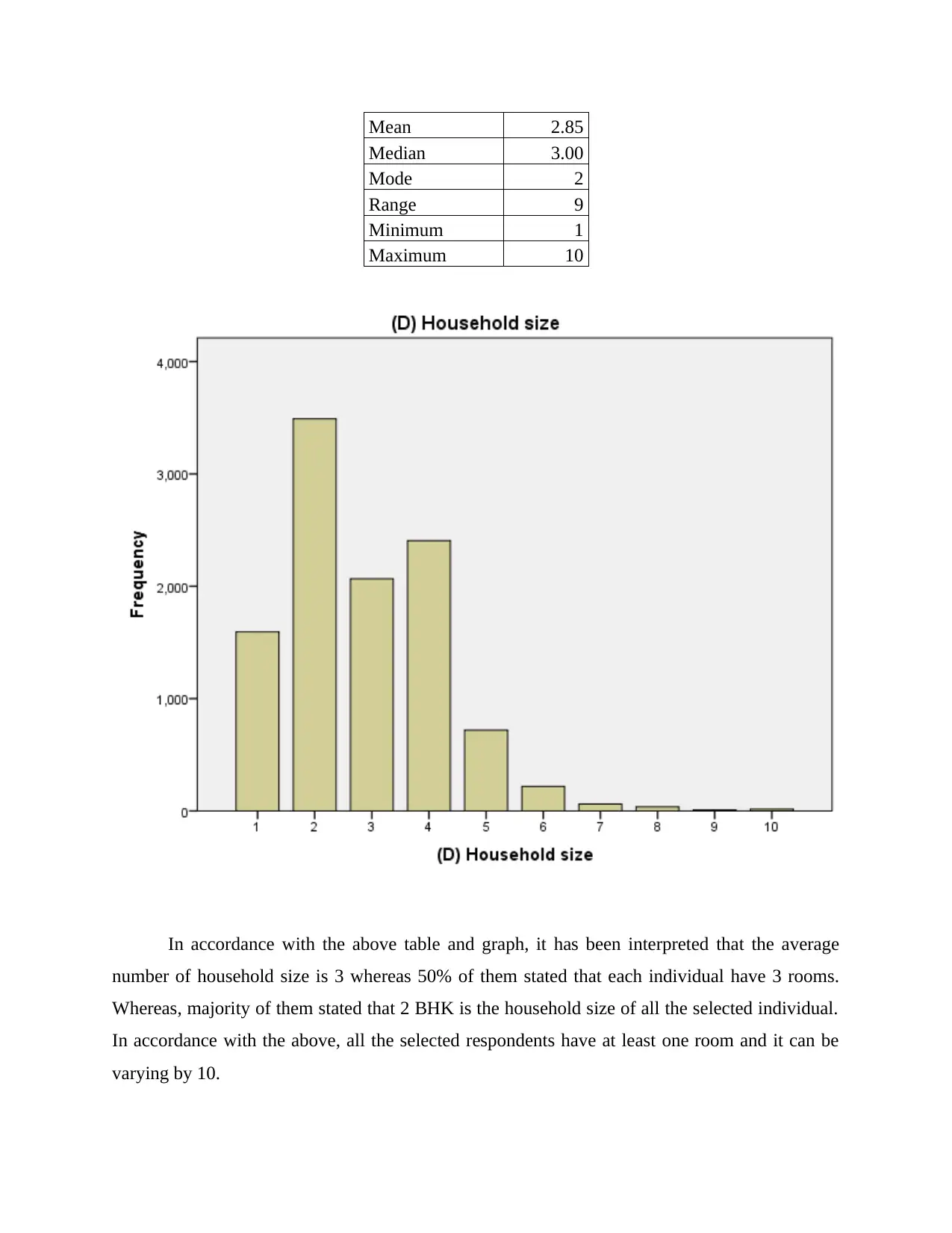
Mean 2.85
Median 3.00
Mode 2
Range 9
Minimum 1
Maximum 10
In accordance with the above table and graph, it has been interpreted that the average
number of household size is 3 whereas 50% of them stated that each individual have 3 rooms.
Whereas, majority of them stated that 2 BHK is the household size of all the selected individual.
In accordance with the above, all the selected respondents have at least one room and it can be
varying by 10.
Median 3.00
Mode 2
Range 9
Minimum 1
Maximum 10
In accordance with the above table and graph, it has been interpreted that the average
number of household size is 3 whereas 50% of them stated that each individual have 3 rooms.
Whereas, majority of them stated that 2 BHK is the household size of all the selected individual.
In accordance with the above, all the selected respondents have at least one room and it can be
varying by 10.
Paraphrase This Document
Need a fresh take? Get an instant paraphrase of this document with our AI Paraphraser
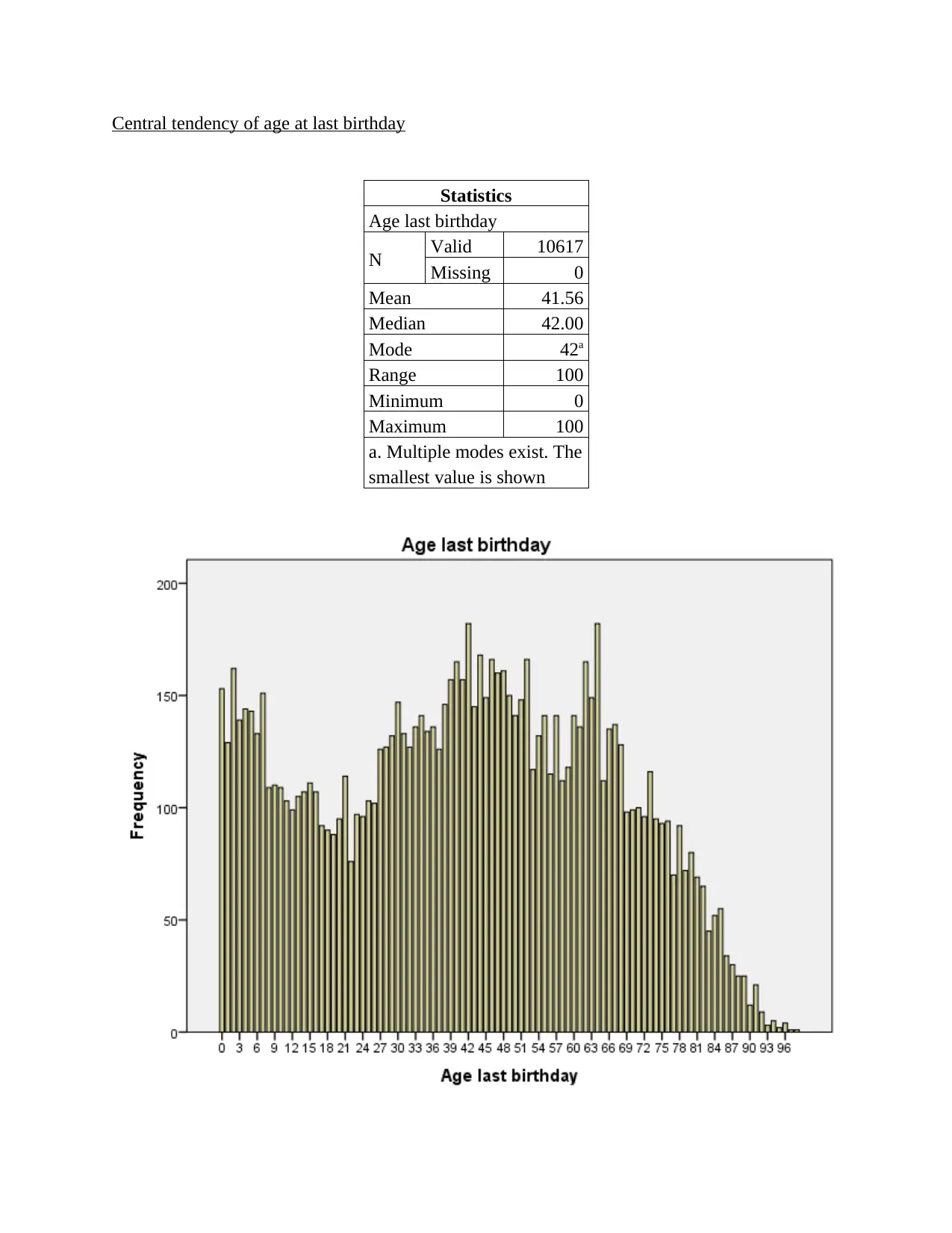
Central tendency of age at last birthday
Statistics
Age last birthday
N Valid 10617
Missing 0
Mean 41.56
Median 42.00
Mode 42a
Range 100
Minimum 0
Maximum 100
a. Multiple modes exist. The
smallest value is shown
Statistics
Age last birthday
N Valid 10617
Missing 0
Mean 41.56
Median 42.00
Mode 42a
Range 100
Minimum 0
Maximum 100
a. Multiple modes exist. The
smallest value is shown
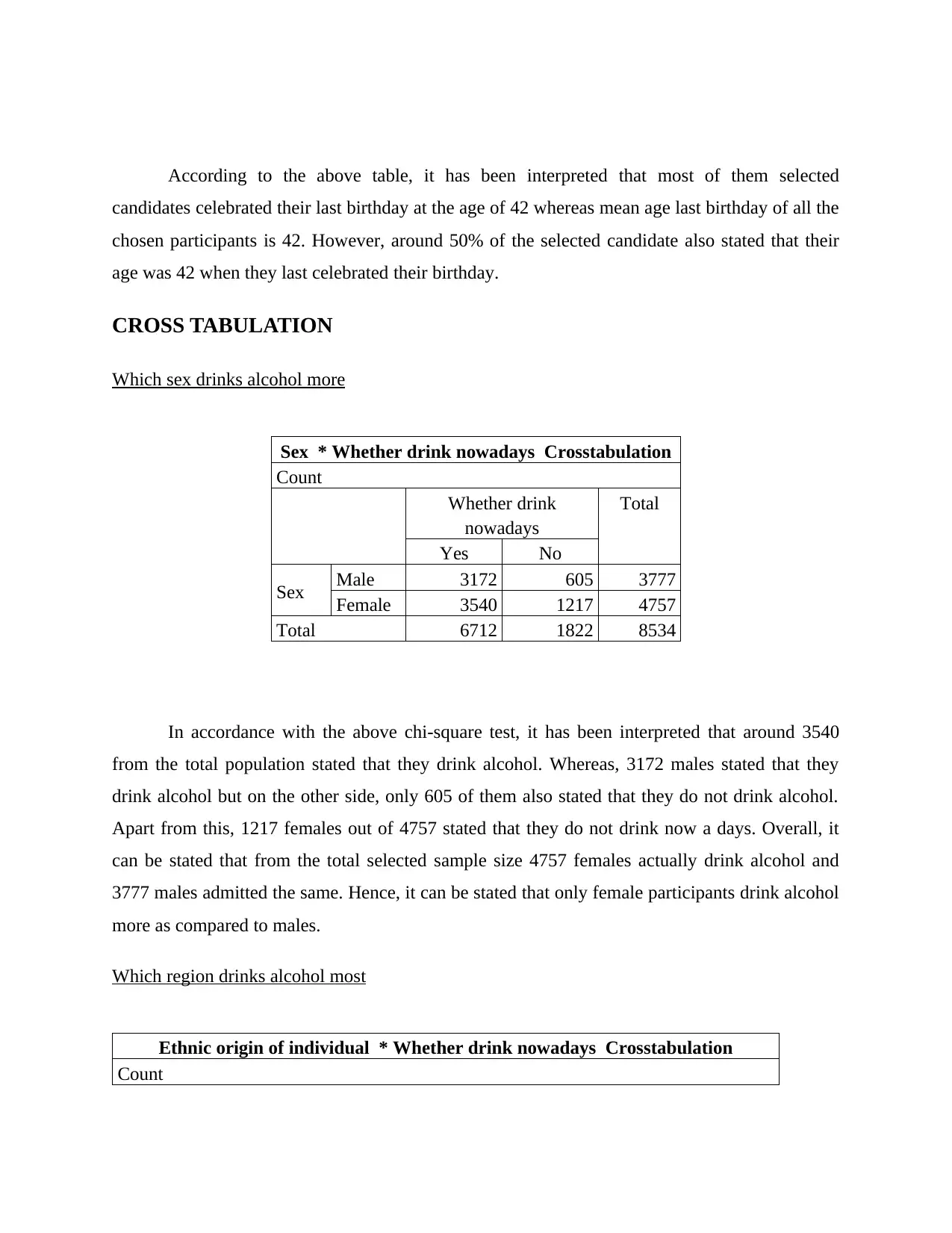
According to the above table, it has been interpreted that most of them selected
candidates celebrated their last birthday at the age of 42 whereas mean age last birthday of all the
chosen participants is 42. However, around 50% of the selected candidate also stated that their
age was 42 when they last celebrated their birthday.
CROSS TABULATION
Which sex drinks alcohol more
Sex * Whether drink nowadays Crosstabulation
Count
Whether drink
nowadays
Total
Yes No
Sex Male 3172 605 3777
Female 3540 1217 4757
Total 6712 1822 8534
In accordance with the above chi-square test, it has been interpreted that around 3540
from the total population stated that they drink alcohol. Whereas, 3172 males stated that they
drink alcohol but on the other side, only 605 of them also stated that they do not drink alcohol.
Apart from this, 1217 females out of 4757 stated that they do not drink now a days. Overall, it
can be stated that from the total selected sample size 4757 females actually drink alcohol and
3777 males admitted the same. Hence, it can be stated that only female participants drink alcohol
more as compared to males.
Which region drinks alcohol most
Ethnic origin of individual * Whether drink nowadays Crosstabulation
Count
candidates celebrated their last birthday at the age of 42 whereas mean age last birthday of all the
chosen participants is 42. However, around 50% of the selected candidate also stated that their
age was 42 when they last celebrated their birthday.
CROSS TABULATION
Which sex drinks alcohol more
Sex * Whether drink nowadays Crosstabulation
Count
Whether drink
nowadays
Total
Yes No
Sex Male 3172 605 3777
Female 3540 1217 4757
Total 6712 1822 8534
In accordance with the above chi-square test, it has been interpreted that around 3540
from the total population stated that they drink alcohol. Whereas, 3172 males stated that they
drink alcohol but on the other side, only 605 of them also stated that they do not drink alcohol.
Apart from this, 1217 females out of 4757 stated that they do not drink now a days. Overall, it
can be stated that from the total selected sample size 4757 females actually drink alcohol and
3777 males admitted the same. Hence, it can be stated that only female participants drink alcohol
more as compared to males.
Which region drinks alcohol most
Ethnic origin of individual * Whether drink nowadays Crosstabulation
Count
⊘ This is a preview!⊘
Do you want full access?
Subscribe today to unlock all pages.

Trusted by 1+ million students worldwide
1 out of 19
Your All-in-One AI-Powered Toolkit for Academic Success.
+13062052269
info@desklib.com
Available 24*7 on WhatsApp / Email
![[object Object]](/_next/static/media/star-bottom.7253800d.svg)
Unlock your academic potential
Copyright © 2020–2025 A2Z Services. All Rights Reserved. Developed and managed by ZUCOL.
